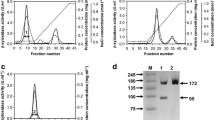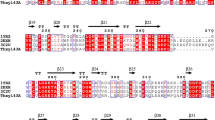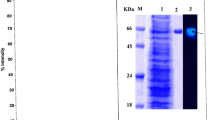Abstract
β-Xylosidases are critical for complete degradation of xylan, the second main constituent of plant cell walls. A minor β-xylosidase (BXYL II) from Penicillium janczewskii was purified by ammonium sulfate precipitation (30% saturation) followed by DEAE-Sephadex chromatography in pH 6.5 and elution with KCl. The enzyme presented molecular weight (MW) of 301 kDa estimated by size exclusion chromatography. Optimal activity was observed in pH 3.0 and 70–75 °C, with higher stability in pH 3.0–4.5 and half-lives of 11, 5, and 2 min at 65, 70, and 75 °C, respectively. Inhibition was moderate with Pb+2 and citrate and total with Cu+2, Hg+2, and Co+2. Partially purified BXYL II and BXYL I (the main β-xylosidase from this fungus) were individually immobilized and stabilized in glyoxyl agarose gels. At 65 °C, immobilized BXYL I and BXYL II presented half-lives of 4.9 and 23.1 h, respectively, therefore being 12.3-fold and 33-fold more stable than their unipuntual CNBr derivatives (reference mimicking soluble enzyme behaviors). During long-term incubation in pH 5.0 at 50 °C, BXYL I and BXYL II glyoxyl derivatives preserved 85 and 35% activity after 25 and 7 days, respectively. Immobilized BXYL I retained 70% activity after 10 reuse cycles of p-nitrophenyl-β-D-xylopyranoside hydrolysis.








Similar content being viewed by others
Abbreviations
- p-NPX:
-
p-Nitrophenyl β-D-xylopyranoside
- PEG:
-
Polyethylene glycol
- PEI:
-
Polyethylenimine
- SDS:
-
Sodium dodecyl sulfate
References
Dodd, D., & Cann, I. K. O. (2009). Enzymatic deconstruction of xylan for biofuel production. Global Change Biology. Bioenergy, 1(1), 2–17. doi:10.1111/j.1757-1707.2009.01004.x.
Jordan, D. B., & Wagschal, K. (2010). Properties and applications of microbial β-D-xylosidases featuring the catalytically efficient enzyme from Selenomonas ruminantium. Applied Microbiology and Biotechnology, 86(6), 1647–1658. doi:10.1007/s00253-010-2538-y.
Zhang, J., & Viikari, L. (2012). Xylo-oligosaccharides are competitive inhibitors of cellobiohydrolase I from Thermoascus aurantiacus. Bioresource Technology, 117, 286–291. doi:10.1016/j.biortech.2012.04.072.
Dhiman, S. S., Sharma, J., & Battan, B. (2008). Industrial applications and future prospects of microbial xylanases: a review. BioResources, 3(4), 1377–1402.
Deutschmann, R., & Dekker, R. F. H. (2012). From plant biomass to bio-based chemicals: latest developments in xylan research. Biotechnology Advances, 30(6), 1627–1640. doi:10.1016/j.biotechadv.2012.07.001.
Goswami, G., & Pathak, R. (2013). Microbial xylanases and their biomedical applications: a review. International Journal of Basic & Clinical Pharmacology, 2(3), 237. doi:10.5455/2319-2003.ijbcp20130602.
Juturu, V., & Wu, J. C. (2012). Microbial xylanases: engineering, production and industrial applications. Biotechnology Advances, 30(6), 1219–1227. doi:10.1016/j.biotechadv.2011.11.006.
Polizeli, M. L. T. M., Rizzatti, A. C. S., Monti, R., Terenzi, H. F., Jorge, J. A., & Amorim, D. S. (2005). Xylanases from fungi: properties and industrial applications. Applied Microbiology and Biotechnology, 67(5), 577–591. doi:10.1007/s00253-005-1904-7.
Cragg, S. M., Beckham, G. T., Bruce, N. C., Bugg, T. D. H., Distel, D. L., Dupree, P., & Zimmer, M. (2015). Lignocellulose degradation mechanisms across the tree of life. Current Opinion in Chemical Biology, 29, 108–119. doi:10.1016/j.cbpa.2015.10.018.
Homaei, A. A., Sariri, R., Vianello, F., & Stevanato, R. (2013). Enzyme immobilization: an update. Journal of Chemical Biology, 6(4), 185–205. doi:10.1007/s12154-013-0102-9.
Knob, A., Terrasan, C. R. F., & Carmona, E. C. (2010). β-Xylosidases from filamentous fungi: an overview. World Journal of Microbiology and Biotechnology, 26(3), 389–407. doi:10.1007/s11274-009-0190-4.
Fernandez-Lafuente, R. (2009). Stabilization of multimeric enzymes: strategies to prevent subunit dissociation. Enzyme and Microbial Technology, 45(6–7), 405–418. doi:10.1016/j.enzmictec.2009.08.009.
Aragon, C. C., Mateo, C., Ruiz-Matute, A. I., Corzo, N., Fernandez-Lorente, G., Sevillano, L., & Guisan, J. M. (2013). Production of xylo-oligosaccharides by immobilized-stabilized derivatives of endo-xylanase from Streptomyces halstedii. Process Biochemistry, 48(3), 478–483. doi:10.1016/j.procbio.2013.01.010.
Driss, D., Haddar, A., Ghorbel, R., & Chaabouni, S. E. (2014). Production of xylooligosaccharides by immobilized His-tagged recombinant xylanase from Penicillium occitanis on nickel-chelate Eupergit C. Applied Biochemistry and Biotechnology, 173(6), 1405–1418. doi:10.1007/s12010-014-0932-0.
Liu, M., Huo, W., Xu, X., & Jin, D. (2015). An immobilized bifunctional xylanase on carbon-coated chitosan nanoparticles with a potential application in xylan-rich biomass bioconversion. Journal of Molecular Catalysis B: Enzymatic, 120, 119–126. doi:10.1016/j.molcatb.2015.07.002.
Terrasan, C. R. F., Aragon, C. C., Masui, D. C., Pessela, B. C., Fernandez-Lorente, G., Carmona, E. C., & Guisan, J. M. (2016). β-xylosidase from Selenomonas ruminantium: immobilization, stabilization and application for xylooligosaccharide hydrolysis. Biocatalysis and Biotransformation (in print).
Terrasan, C. R. F., Temer, B., Duarte, M. C. T., & Carmona, E. C. (2010). Production of xylanolytic enzymes by Penicillium janczewskii. Bioresource Technology, 101(11), 4139–4143. doi:10.1016/j.biortech.2010.01.011.
Temer, B., Terrasan, C. R. F., & Carmona, E. C. (2014). α-L-arabinofuranosidase from Penicillium janczewskii: production with brewer’s spent grain and orange waste. African Journal of Biotechnology, 13(17), 1796–1806. doi:10.5897/AJB2013.13361.
Terrasan, C. R. F., Guisan, J. M., & Carmona, E. C. (2016). Xylanase and β-xylosidase from Penicillium janczewskii: purification, characterization and hydrolysis of substrates. Electronic Journal of Biotechnology, 19(5), 54–62. doi:10.1016/j.ejbt.2016.08.001.
Terrasan, C. R. F., Trobo-Maseda, L., Moreno-Pérez, S., Carmona, E. C., Pessela, B. C., & Guisan, J. M. (2016). Co-immobilization and stabilization of xylanase, β-xylosidase and α-L-arabinofuranosidase from Penicillium janczewskii for arabinoxylan hydrolysis. Process Biochemistry, 51(5), 614–623. doi:10.1016/j.procbio.2016.02.014.
Kersters-Hilderson, H., Claeyssens, M., Van Doorslaer, E., Saman, E., & De Bruyne, C. K. (1982). Complex Carbohydrates Part D. Methods in Enzymology, vol 83. Elsevier. doi:10.1016/0076–6879(82)83062-0.
Lowry, O. H., Rosebrough, N. J., Farr, A. L., & Randall, R. J. (1951). Protein measurement with the Folin phenol reagent. The Journal of Biological Chemistry, 193(1), 265–275.
Laemmli, U. K. (1970). Cleavage of structural proteins during the assembly of the head of bacteriophage T4. Nature, 227(5259), 680–685. doi:10.1038/227680a0.
Mateo, C., Palomo, J. M., Fuentes, M., Betancor, L., Grazu, V., López-Gallego, F., & Guisán, J. M. (2006). Glyoxyl agarose: a fully inert and hydrophilic support for immobilization and high stabilization of proteins. Enzyme and Microbial Technology, 39(2), 274–280. doi:10.1016/j.enzmictec.2005.10.014.
Fernandez-Lafuente, R., Rosell, C. M., Rodriguez, V., Santana, C., Soler, G., Bastida, A., & Guisán, J. M. (1993). Preparation of activated supports containing low pK amino groups. A new tool for protein immobilization via the carboxyl coupling method. Enzyme and Microbial Technology, 15(7), 546–550. doi:10.1016/0141-0229(93)90016-U.
Mateo, C., Pessela, B. C. C., Fuentes, M., Torres, R., Betancor, L., Hidalgo, A., & Guisan, J. M. (2006). Stabilization of multimeric enzymes via immobilization and further cross-linking with aldehyde-dextran. 22, 129–41. doi:10.1007/978–1–59745-053-9_12.
Fernandez-Lafuente, R., Rosell, C. M., Rodriguez, V., & Guisan, J. M. (1995). Strategies for enzyme stabilization by intramolecular crosslinking with bifunctional reagents. Enzyme and Microbial Technology, 17(6), 517–523. doi:10.1016/0141-0229(94)00090-E.
Betancor, L., López-Gallego, F., Alonso-Morales, N., Dellamora, G., Mateo, C., Fernandez-Lafuente, R., & Guisan, J. (2006). Glutaraldehyde in protein immobilization. In J. M. Guisan (Ed.), Immobilization of enzymes and cells SE – 5, vol 22 (pp 57–64). Humana Press. doi:10.1007/978–1–59745-053-9_5.
Ito, T., Yokoyama, E., Sato, H., Ujita, M., Funaguma, T., Furukawa, K., & Hara, A. (2003). Xylosidases associated with the cell surface of Penicillium herquei IFO 4674. Journal of Bioscience and Bioengineering, 96(4), 354–359. doi:10.1016/S1389-1723(03)90136-8.
Wakiyama, M., Yoshihara, K., Hayashi, S., & Ohta, K. (2008). Purification and properties of an extracellular β-xylosidase from Aspergillus japonicus and sequence analysis of the encoding gene. Journal of Bioscience and Bioengineering, 106(4), 398–404. doi:10.1263/jbb.106.398.
Knob, A., & Carmona, E. C. (2011). Purification and properties of an acid β-xylosidase from Penicillium sclerotiorum. Annals of Microbiology, 62(2), 501–508. doi:10.1007/s13213-011-0282-x.
Díaz-Malváez, F. I., García-Almendárez, B. E., Hernández-Arana, A., Amaro-Reyes, A., & Regalado-González, C. (2013). Isolation and properties of β-xylosidase from Aspergillus niger GS1 using corn pericarp upon solid state fermentation. Process Biochemistry, 48(7), 1018–1024. doi:10.1016/j.procbio.2013.05.003.
Nieto-Domínguez, M., de Eugenio, L. I., Barriuso, J., Prieto, A., Fernández de Toro, B., Canales-Mayordomo, A., & Martínez, M. J. (2015). Novel pH-stable glycoside hydrolase family 3 β-xylosidase from Talaromyces amestolkiae: an enzyme displaying regioselective transxylosylation. Applied and Environmental Microbiology, 81(18), 6380–6392. doi:10.1128/AEM.01744-15.
Rizzatti, A. C., Jorge, J. A., Terenzi, H. F., Rechia, C. G., & Polizeli, M. L. (2001). Purification and properties of a thermostable extracellular beta-D-xylosidase produced by a thermotolerant Aspergillus phoenicis. Journal of Industrial Microbiology & Biotechnology, 26(3), 156–160. doi:10.1038/sj/jim/7000107.
Lenartovicz, V., Marques De Souza, C. G., Guillen Moreira, F., & Peralta, R. M. (2003). Temperature and carbon source affect the production and secretion of a thermostable β-xylosidase by Aspergillus fumigatus. Process Biochemistry, 38(12), 1775–1780. doi:10.1016/S0032-9592(02)00261-3.
Matsuo, M., Fujie, A., Win, M., & Yasui, T. (1987). Four types of beta-xylosidases from Penicillium wortmanni IFO 7237. Agricultural and Biological Chemistry, 51(9), 2367–2379. doi:10.1271/bbb1961.51.2367.
Kumar, S., & Ramón, D. (1996). Purification and regulation of the synthesis of a β-xylosidase from Aspergillus nidulans. FEMS Microbiology Letters, 135(2–3), 287–293. doi:10.1111/j.1574-6968.1996.tb08003.x.
Bolivar, J. M., Wilson, L., Ferrarotti, S. A., Fernandez-Lafuente, R., Guisan, J. M., & Mateo, C. (2006). Stabilization of a formate dehydrogenase by covalent immobilization on highly activated glyoxyl-agarose supports. Biomacromolecules, 7(3), 669–673. doi:10.1021/bm050947z.
Jordan, D. B., Li, X. L., Dunlap, C. A., Whitehead, T. R., & Cotta, M. A. (2007). β-D-xylosidase from Selenomonas ruminantium of glycoside hydrolase family 43. Applied Biochemistry and Biotechnology, 137–40, 93–104. doi:10.1007/s12010-007-9042-6.
Acknowledgements
This work was partially sponsored by FAPESP (Project 2010/16582-0) and the Spanish Ministry of Science and Innovation (Project BIO-2012-36861). C.R.F.T. gratefully acknowledges PROPe/UNESP and CAPES/Ministry of Education, Brazil, through the Program Science Without Borders for the postdoctoral scholarship (3134-13-0).
Author information
Authors and Affiliations
Corresponding author
Ethics declarations
Conflict of Interest
The authors declare that they have no conflict of interest.
Electronic supplementary material
ESM 1
Stability of BXYL I from P. janczewskii in pH 10.0 medium with polyethylene glycol. Incubation was carried out with 0.1 M sodium bicarbonate buffer pH 10.0 containing 50% (w/v) PEG MW 6000 and 35,000 in an ice-bath and at room temperature. The activity was assayed in 0.05 M sodium acetate buffer pH 5.0 at 25 °C. Incubation was carried out at room temperature (dashed lines) and in an ice-cold bath (full lines). β-xylosidase activity (%) in medium with PEG (▲, ▵) 6000 and (■, □) PEG 35,000 (JPEG 107 kb)
ESM 2
Immobilization course of BXYL I from P. janczewskii on glyoxyl agarose. Immobilization was performed in 0.1 M sodium bicarbonate buffer pH 10.0 containing 50% (w/v) PEG MW 35,000. Immobilization was initially performed in an ice-cold bath and subsequently the temperature was allowed to gradually increase to room temperature (≈ 25 °C). The activity was assayed in 0.05 M sodium acetate buffer pH 5.0 at 25 °C. β-xylosidase activity (%) in the (●) control, (■) supernatant and (▲) suspension. Vertical dashed line indicates the change in incubation temperature (JPEG 120 kb)
Rights and permissions
About this article
Cite this article
Terrasan, C.R.F., Romero-Fernández, M., Orrego, A.H. et al. Immobilization and Stabilization of Beta-Xylosidases from Penicillium janczewskii . Appl Biochem Biotechnol 182, 349–366 (2017). https://doi.org/10.1007/s12010-016-2331-1
Received:
Accepted:
Published:
Issue Date:
DOI: https://doi.org/10.1007/s12010-016-2331-1




